Published April 16, 2020
Have you ever seen or heard a bird in your backyard and wondered what kind of bird it was?
We’ve created a descriptive list of 24 Ontario birds so that you can identify which ones are visiting your backyard. These birds are some of the most colourful, cheerful, and interesting residents of the Great Lakes region.
Here are 24 birds you might see in your backyard or neighbourhood:
Index
1. American Crow: large and fully black with iridescent feathers
2. American Goldfinch: bright or dark yellow with black and white wings and tails
3. American Robin: grey with red undersides and yellow beaks
4. Black-capped Chickadee: grey backs and light undersides with black accents
5. Blue Jay: blue, white, and black feathers
6. Canada Goose: large with brownish grey feathers and long black necks
7. Cardinal: bright red or brown with reddish accents
8. Cedar Waxwing: warm brown and grey bodies with bright red and yellow accents
9. Common Grackle: iridescent black or dull brown with long bodies
10. Common Nighthawk: grey, black, and brown with white wing patches
11. Downy Woodpecker: small with black and white feathers
12. Eastern Phoebe: round bodies with brown and white feathers
13. European Starling: glossy black feathers with purple or green tones
14. House Sparrow: brown with black, white, and grey accents
15. House Wren: small and brown with short tails
16. Mallard: brown or grey, with brown or green heads
17. Mourning Dove: light gray-brown feathers and small heads
18. Osprey: brown and white with long wings and legs
19. Peregrine Falcon: big with blue-grey feathers, long tails and long pointed wings
20. Red-tailed Hawk: brown with red tails and rounded wings
21. Rock Pigeon: plump with round heads, blue-grey feathers with two wing bars
22. Ruby-throated Hummingbird: metallic green with white or red throats
23. White-breasted Nuthatch: round with black, gray, and white feathers
24. Wood Thrush: brown with white, dark speckled undersides.
1
American Crow:
American Crow description: American Crows are large, fully black birds with iridescent feathers.
Favorite snacks: American Crows eat just about everything (including garbage and carrion), but especially like insects, worms, small animals, and peanuts.
Listen to an American Crow here.
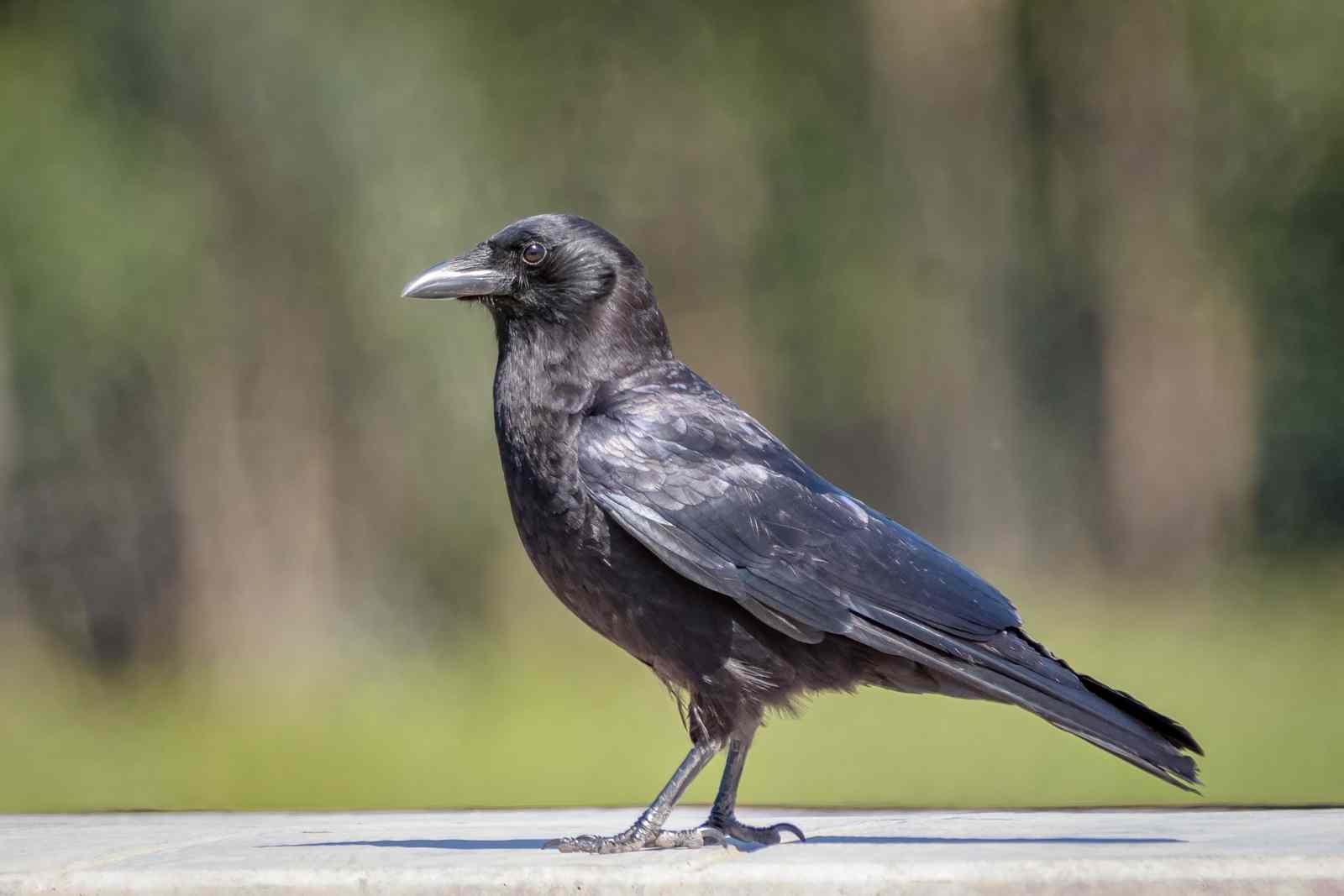
About American Crows:
- American Crows are known for their intelligence.
- When one crow dies, others will gather round to try and figure out what happened.
- They can make and use tools, remember human faces (and warn other crows about unkind humans), and solve problems.
- They’re skilled foragers who will distract other animals to steal their food.
2
American Goldfinch:
American Goldfinch description: Males American Goldfinches are bright yellow with black and white wings and tails. They can look olive coloured in the winter, but they get brighter in the spring. Females are yellow-y brown and they also get brighter in the spring.
Favourite snack: Seeds
Listen to an American Goldfinch here.
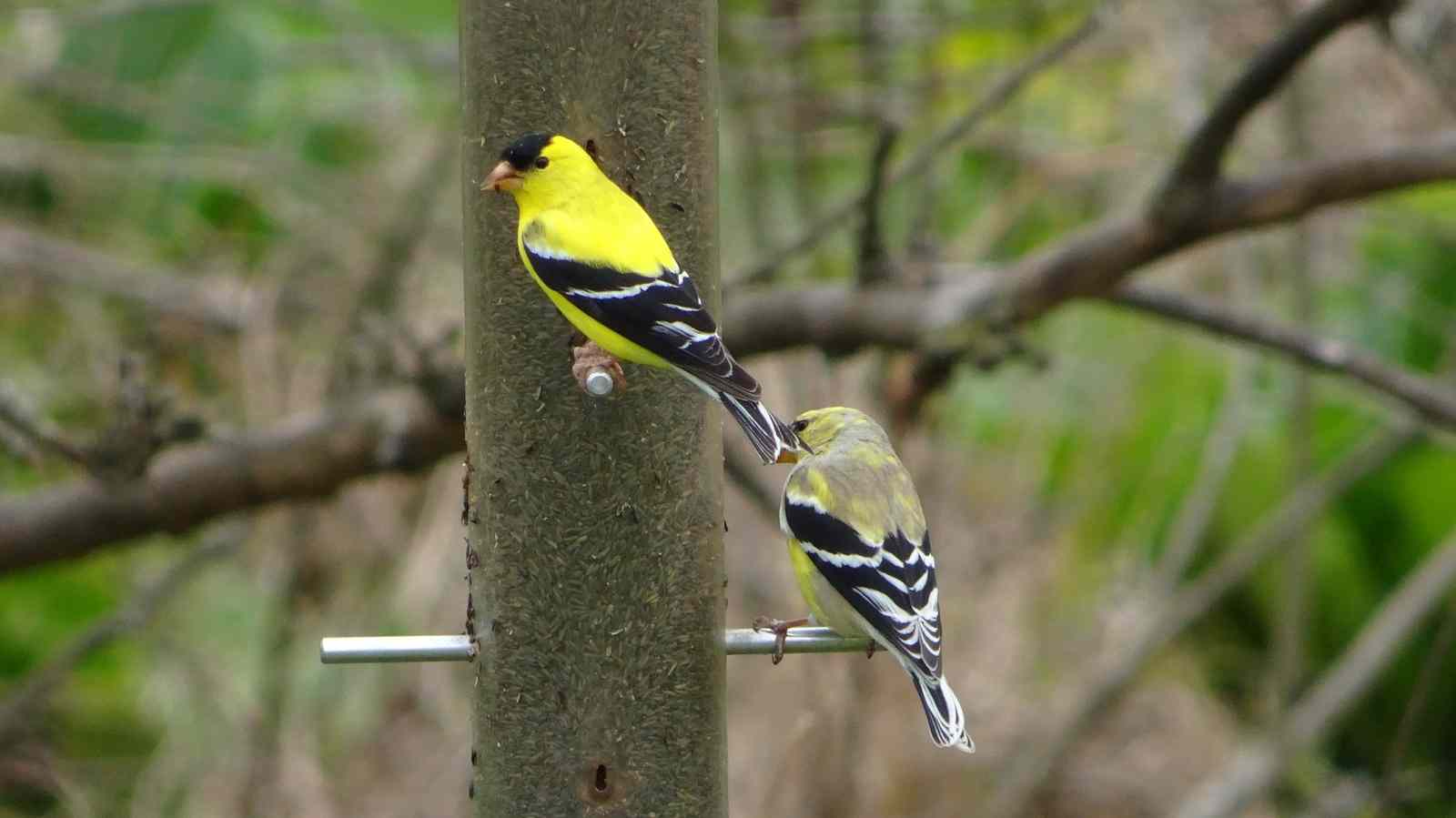
About American Goldfinches
- American Goldfinches are fairly strict vegetarians, unlike many other birds who eat insects. They often only eat insects when they swallow them by accident.
- American Goldfinches are vulnerable to nest parasitism by Brown-headed Cowbirds. This is when one species lays their eggs in another species nest, leaving the other species to care for them. It can lead to competition between the two nestling species However, when Brown-headed Cowbirds leave their eggs in an American Goldfinch nest, the nestlings usually can’t survive on the all-seed diets and usually die within a few days.
3
American Robin
American Robin description: Males American Robins have brick-red/orange undersides, greyish backs, and yellow beaks. Females have the same colouring, but slightly more muted.
Favourite snack: Earthworms in the morning, fruit for lunch and dinner
Listen to an American Robin here.

About American Robins:
- American Robins can make a variety of calls, but are best-known for the cheerful whistling calls made by males. This call sounds like “cheerily cheer up cheerio.”
- Females lay light blue eggs.
- American Robins have very good eyesight. They find worms by standing motionless and keeping an eye out for the smallest movement in the ground.
- They are an indicator species of chemical/pesticide pollution because they feed on lawns.
4
Black-capped Chickadee:
Black-capped Chickadee description: Black-capped Chickadees have grey blacks and light undersides. They look like they have black hair and a black beard with bright white cheeks. Their heads are round and oversized relative to their bodies.
Favourite snack: Sunflower seeds and suet
Listen to a Chickadee here.
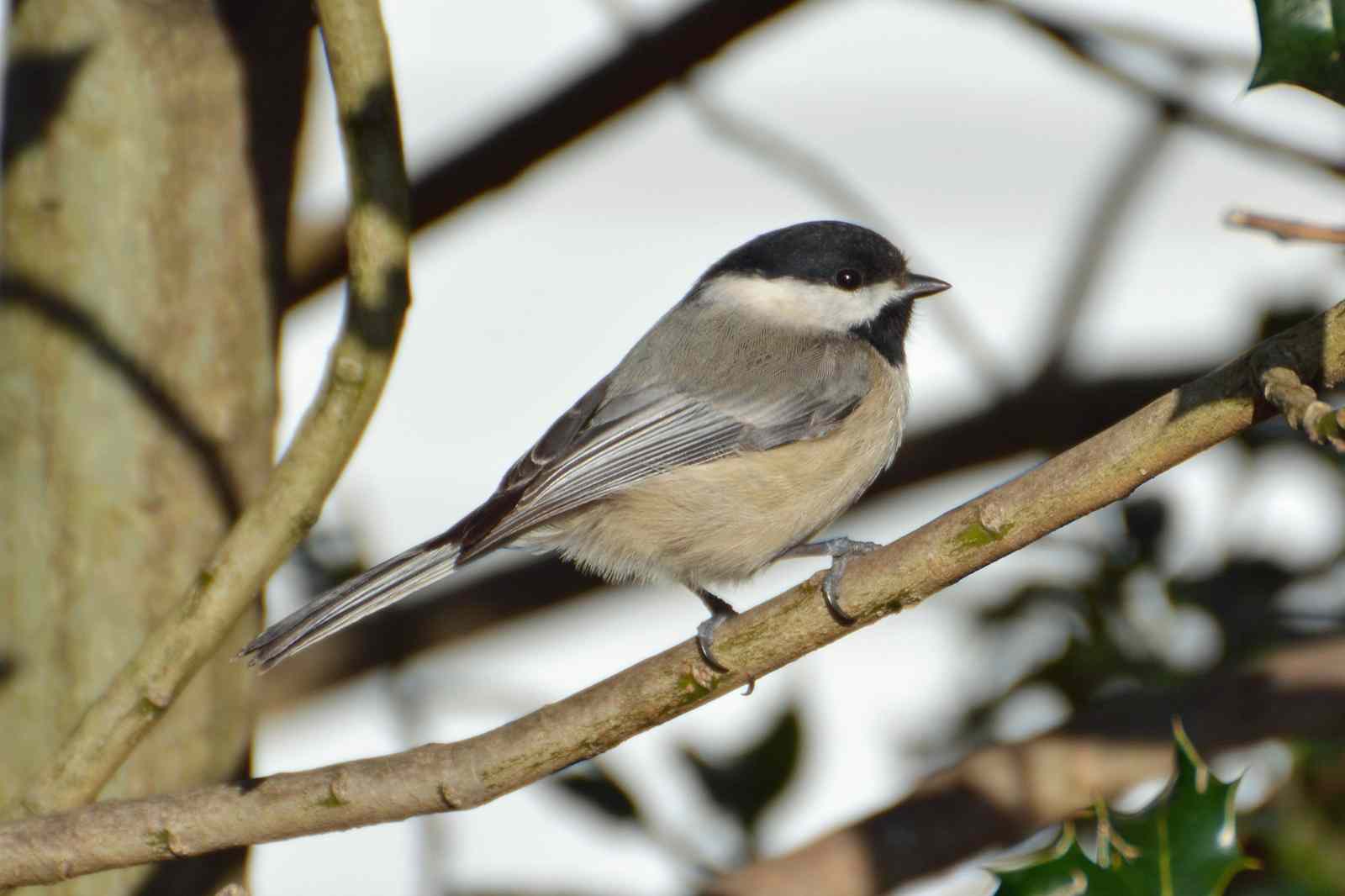
About Black-capped Chickadees:
- Black-capped Chickadees have curious personalities, and will even eat from hands.
- They have 16 different calls, but the most distinctive call sounds like “chickadee-dee-dee.” If there is a predator or danger nearby, the Chickadee will repeat the “dee” part of the call over and over (the more “dees” the more danger there is).
- Chickadees can hide seeds for later and can recall thousands of hiding spots.
- Unlike many birds, they don’t migrate in the winter.
- In the fall, the hippocampus (the ‘remembering’ part of their brain) grows by 30%. This is so that they can recall where they hid seeds during the cold months. Once winter ends, that part of the brain returns back to its normal size.
5
Blue Jay:
Blue Jay description: Blue Jays have blue, white, and black feathers with prominent crests.
Favourite snack: Acorns (In fact, Blue Jays are actually believed to have spread oak trees after the most recent glacial period.)
Listen to a Blue Jay here.
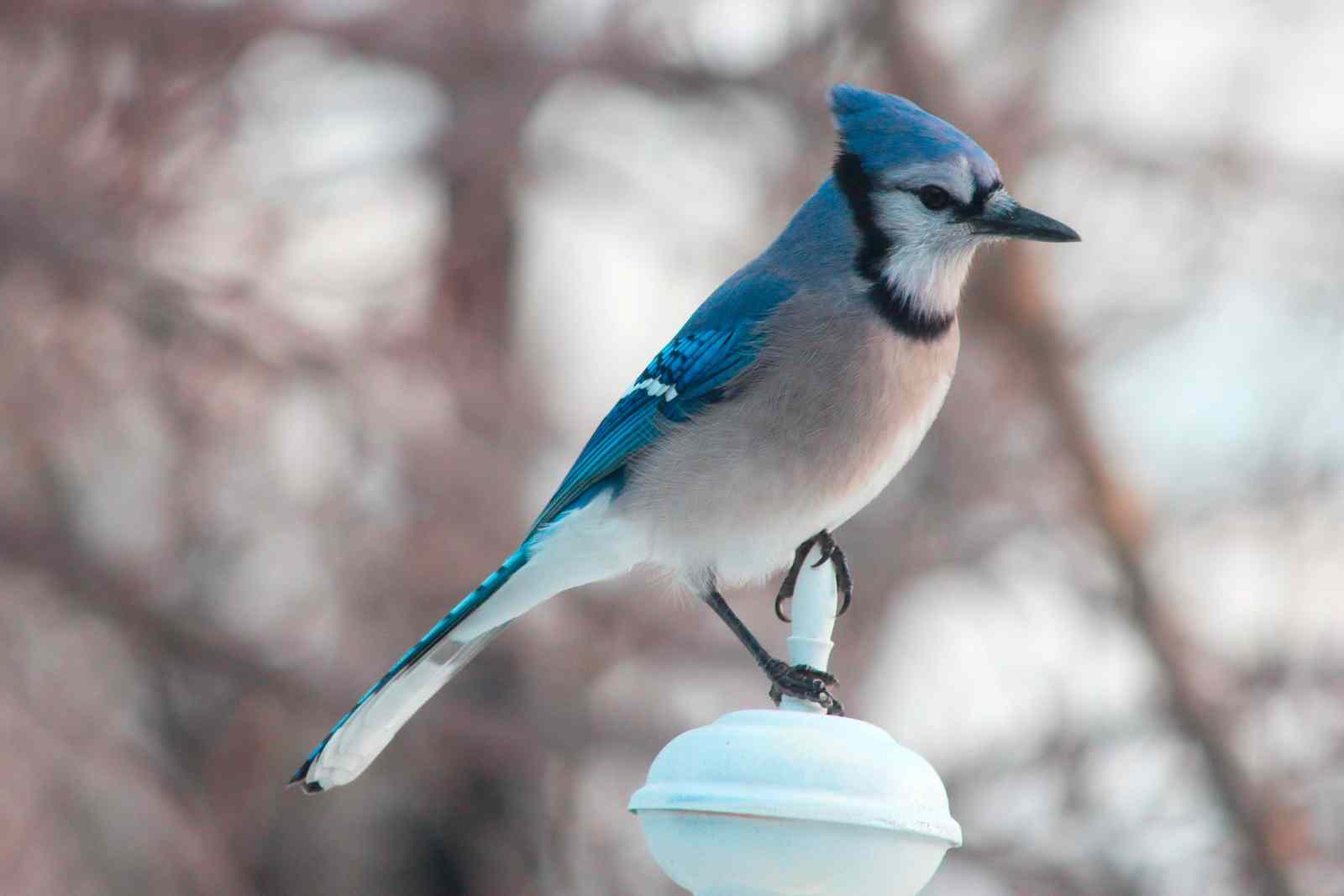
About Blue Jays:
- Blue Jays are very intelligent. They have complex social systems and they form close bonds with family.
- Usually Blue Jays’ calls are loud and aggressive-sounding, but they are also able to mimic hawk calls to warn other birds one is in the area, or even to deceive birds into thinking one is nearby.
- Although it’s right there in the name, a Blue Jay’s feathers aren’t actually blue. The blue appearance is caused by the feathers’ inner structure, which distorts the light reflected off the bird.
- You can tell a Blue Jay’s mood by looking at its crest. If it’s standing up, the bird is excited or upset. If it’s sticking out in many directions, the bird is afraid.
6
Canada Goose:
Canada Goose description: Canada Geese are brownish grey with long black necks and white chinstrap markings.
Favourite snack: Small aquatic plants and animals and grass
Listen to a Canada Goose here.
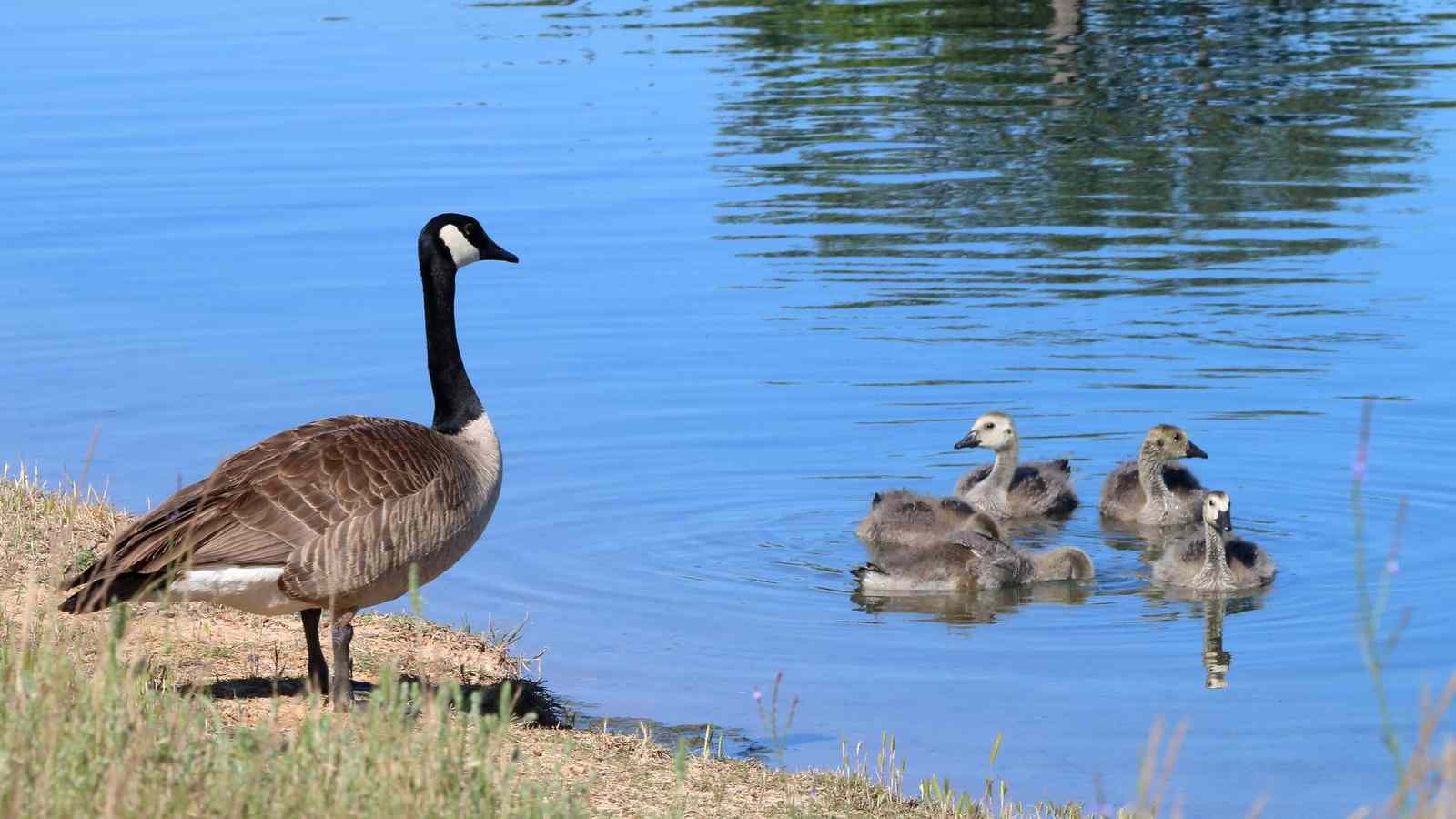
About Canada Geese:
- Canada Geese are perhaps best known for their distinctive honking sound.
- They are also well-known for their V-shaped migration formations.
- Pairs can mate for 20 years, and can live for 30 years.
- Male Canada Geese are fearless when defending females and goslings. They’ve charged animals as big as an elk!
- Goslings learn to swim less than a day after being born.
7
Cardinal:
Cardinal description: Cardinals have sharp crests (tufts of feathers on their heads). Males are bright red and females are brown with reddish accents on their heads, wings, and tails.
Favourite snack: Sunflower seeds
Listen to a Cardinal here.
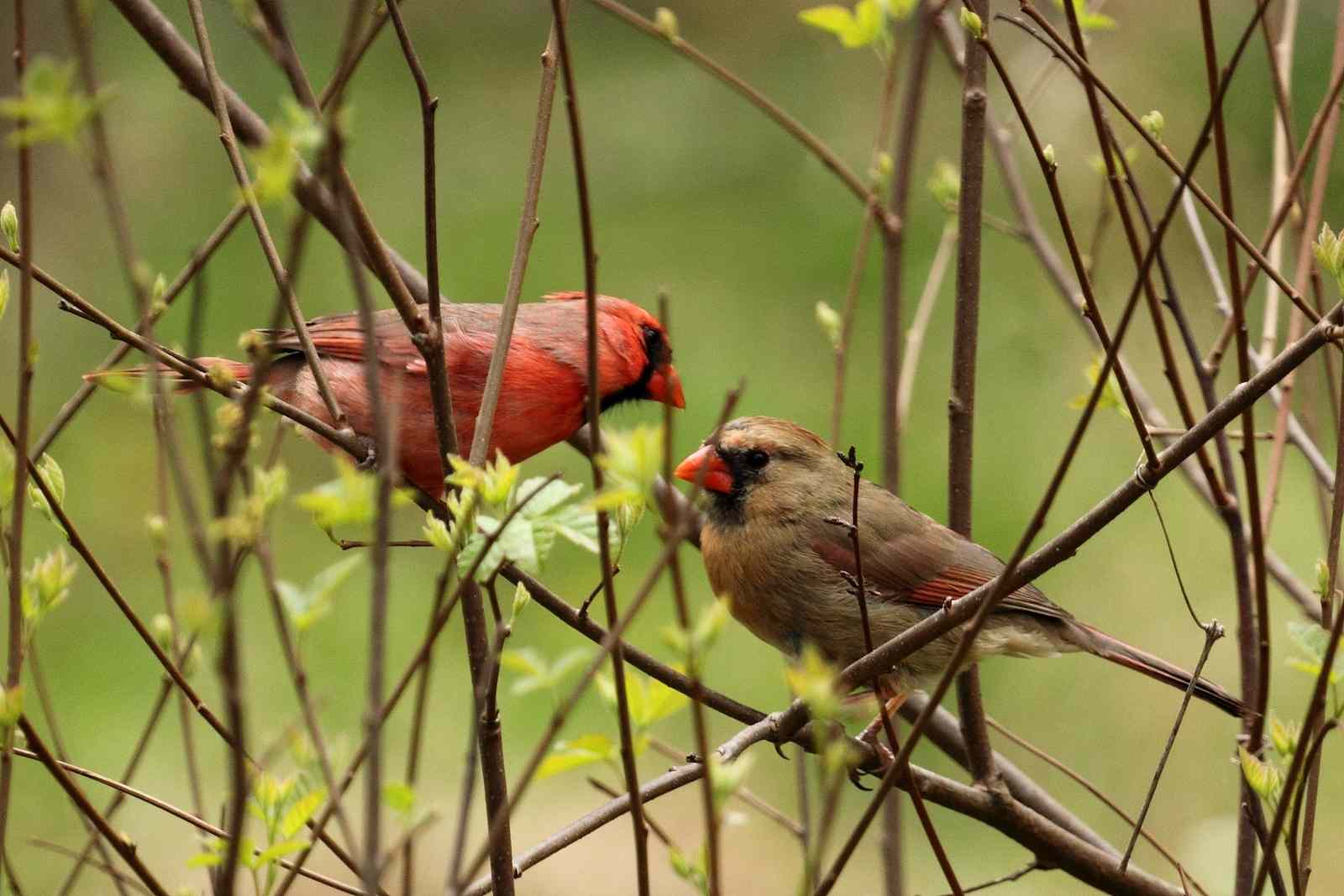
About Cardinals:
- The female Northern Cardinal is one of the few female North American songbirds that sings.
- They are local resident birds, so you can spot them in your backyard all year-round.
- You’ve likely seen the Cardinal on the front of a Christmas card. They have been deemed the “Christmas bird” with their red feathers standing out brilliantly against the white winter snow.
- Some believe that the Cardinal is thought to represent a loved one who has passed. When you see one, it means they are visiting you.
8
Cedar Waxwing
Cedar Waxwing description: Cedar Waxwings have warm cinnamon-brown and grey bodies with bright yellow tails, pale yellow undersides, red wing tips, black eye markings, and crested heads.
Favourite snack: Fruit and berries (like elderberries and mulberies)
Listen to a Cedar Waxwing here.
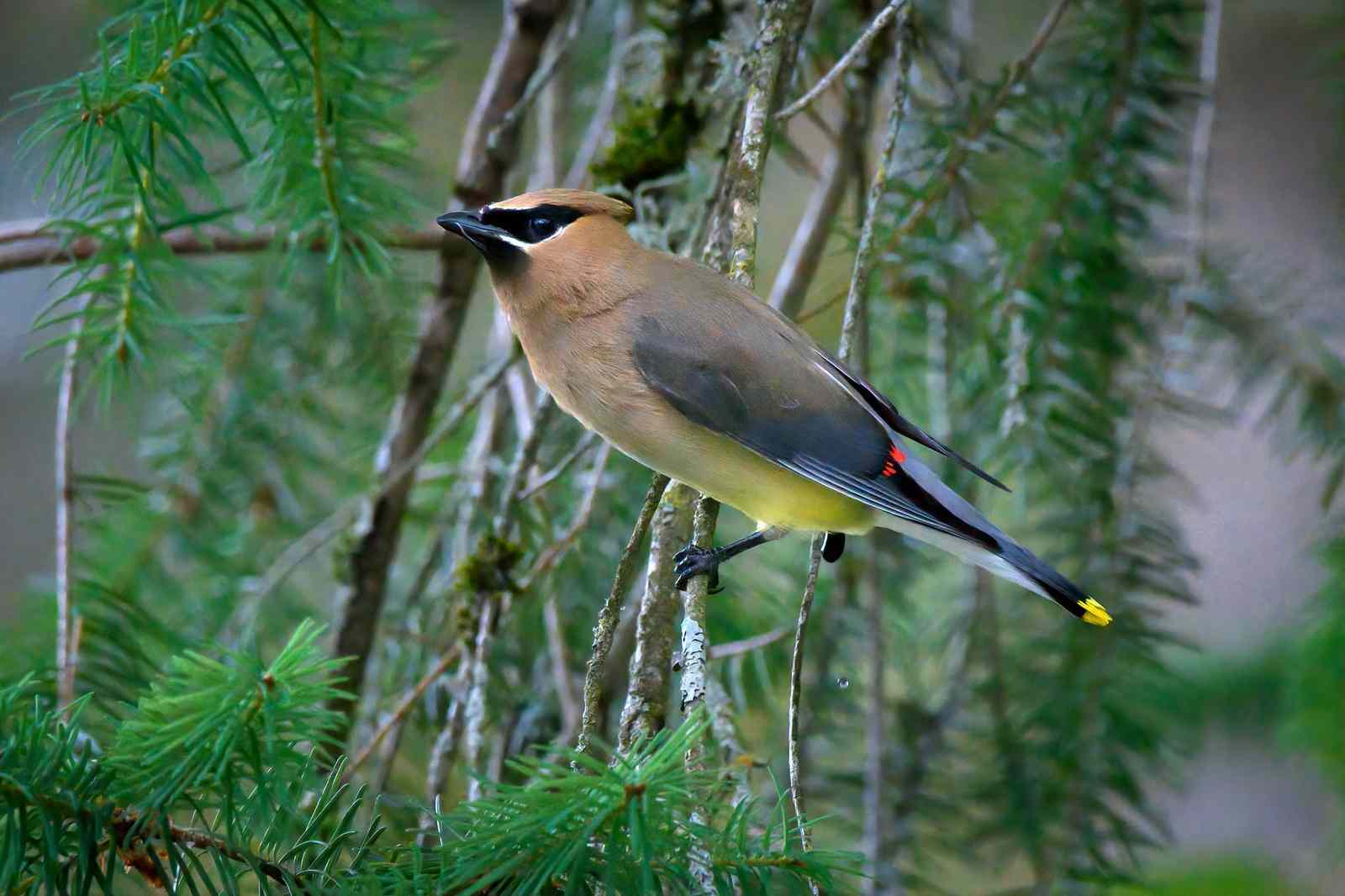
About Cedar Waxwings:
- Cedar Waxwings are named for the waxy red deposits on the tips of their feathers. The purpose of the secretions is unknown, though some scientists speculate that they may be used for mating.
- In America’s northeast and Canada’s southeast in the 1960s, Cedar Waxwings with orange instead of yellow tail tips started showing up. It’s believed that the change in colour happened because a new species of honeysuckle was introduced that had red pigmented berries eaten by Cedar Waxwings.
- Cedar Waxwings can survive on fruit for months. Since they have such fruit-filled diets, they sometimes get drunk off of fermented berries and fly into windows.
9
Common Grackle:
Common Grackle description: Long black birds (the tallest and longest of the blackbirds) with iridescent feathers. Females look similar but are smaller, browner, and less glossy.
Favourite snack: Corn and other crops are a favourite, but Common Grackles are opportunistic foragers. They will also eat mice, fish, leeches, other birds, other birds’ eggs, hot dogs, and garbage.
Listen to a Common Grackle here.
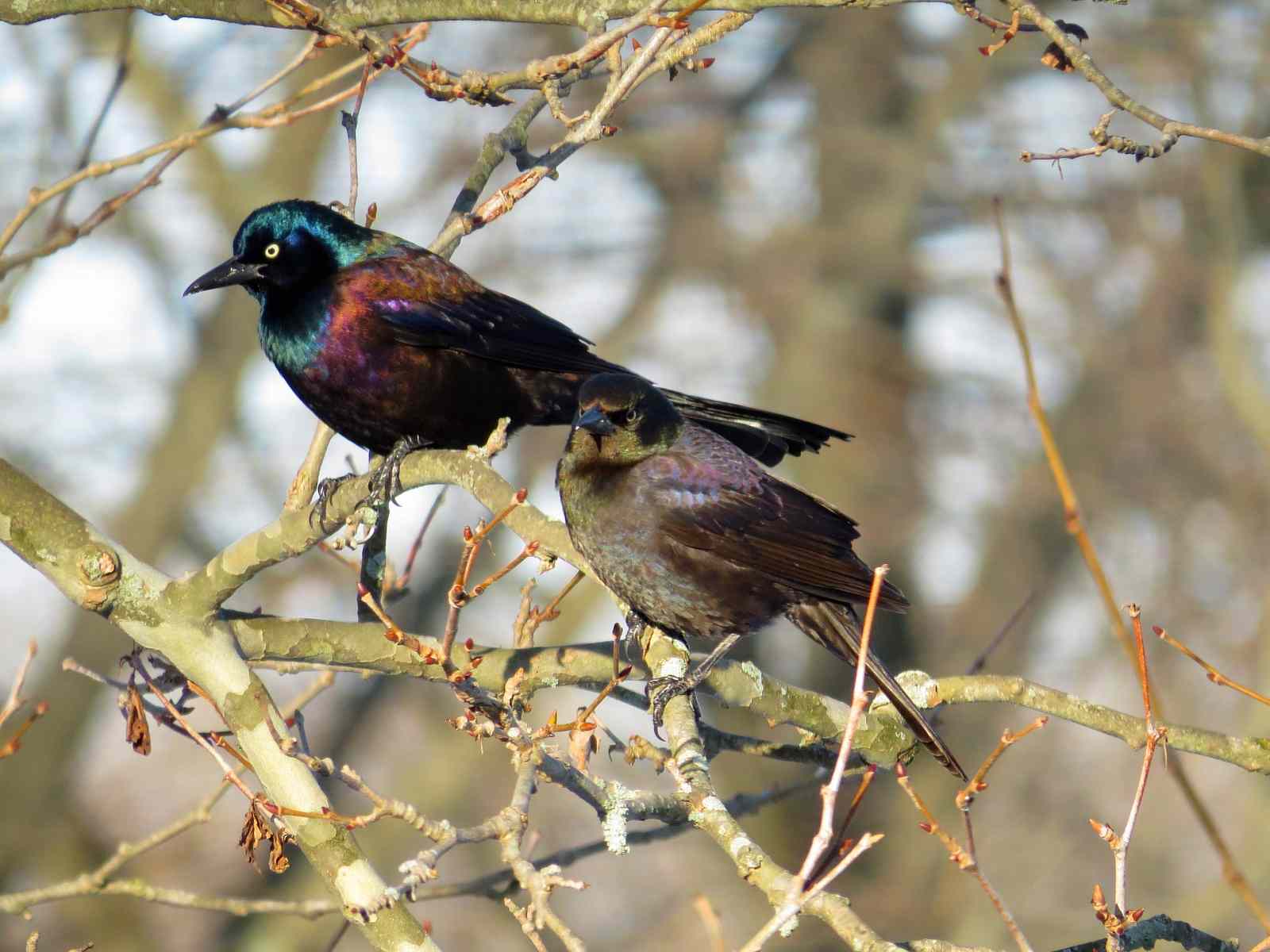
About Common Grackles:
- You’ll know the Common Grackle by their loud calls which are especially harsh.
- Their voices are varied. They can make squeaks, croaks, whistles, and can mimic other birds.
- Grackles engage in behaviour called “anting.” When they do this, they crouch on the ground with their wings spread and let ants crawl all over their body. The ants release formic acid, which may help with parasites, though some theorize this is actually to help with molting.
10
Common Nighthawk:
Common Nighthawk description: Common Nighthawks have grey, black, and brown feathers and long wings that have white patches width-ways.
Favourite snack: Flying insects, like mosquitoes and moths
Listen to a Common Nighthawk here.
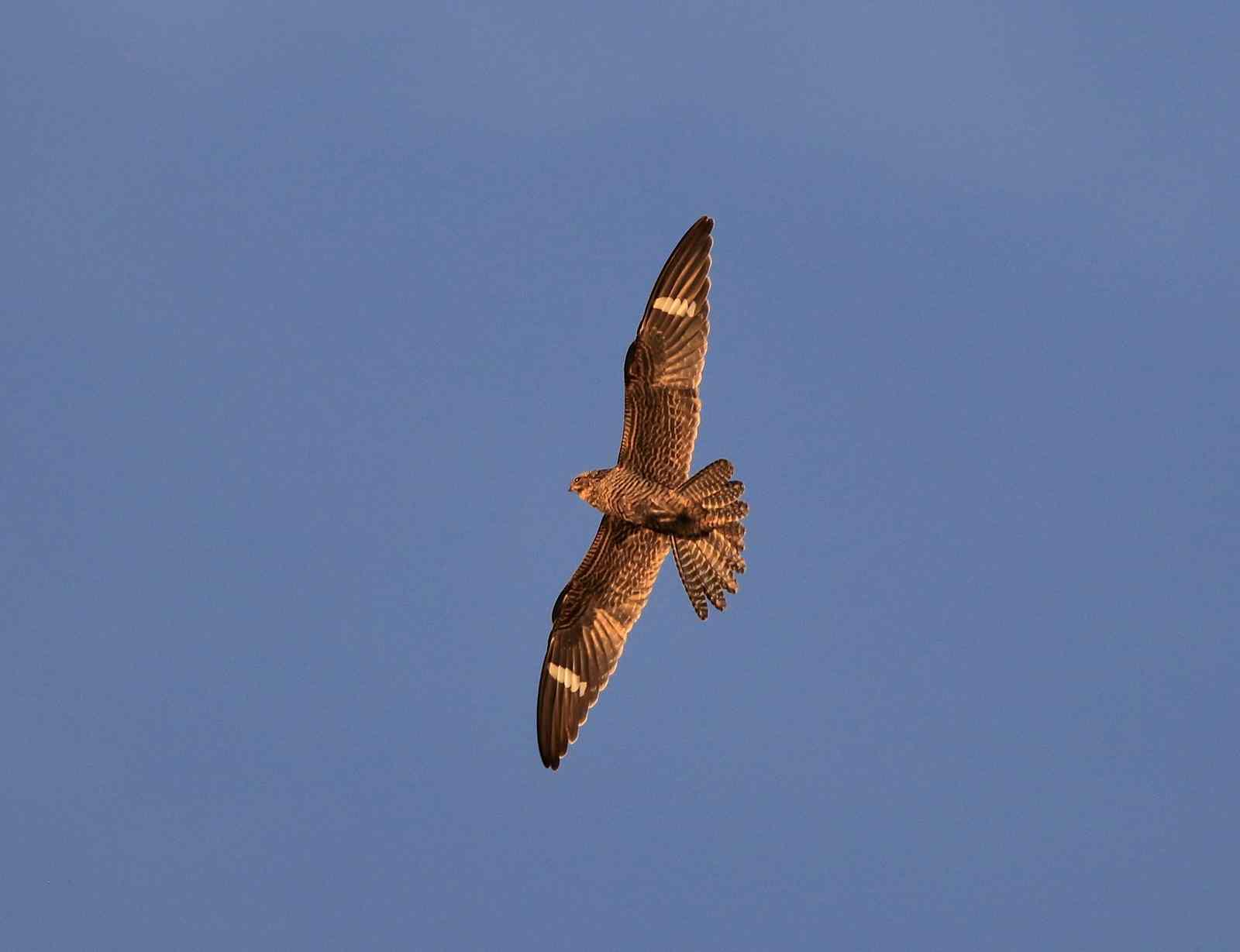
About Common Nighthawks:
- These nocturnal birds can often be spotted at dusk and dawn in the summer.
- You may hear the Nighthawk before you see it. They have distinct electrical sounding “peent” calls.
- Males do something called ‘booms.’ This is when they quickly dive downwards, making a whooshing sound. The display is used for courting females or to warn intruders off their territory.
- Common Nighthawks have one of the longest migrations of birds in North America. They have been found as far away as Iceland and the British Isles.
11
Downy Woodpecker (You might also see: Hairy Woodpecker)
Downy Woodpecker description: Downy Woodpeckers are very small woodpeckers with black and white feathers. Males have red feathers on their heads.
Favourite snack: Suet, millet, sunflower seeds
Listen to a Downy Woodpecker here.
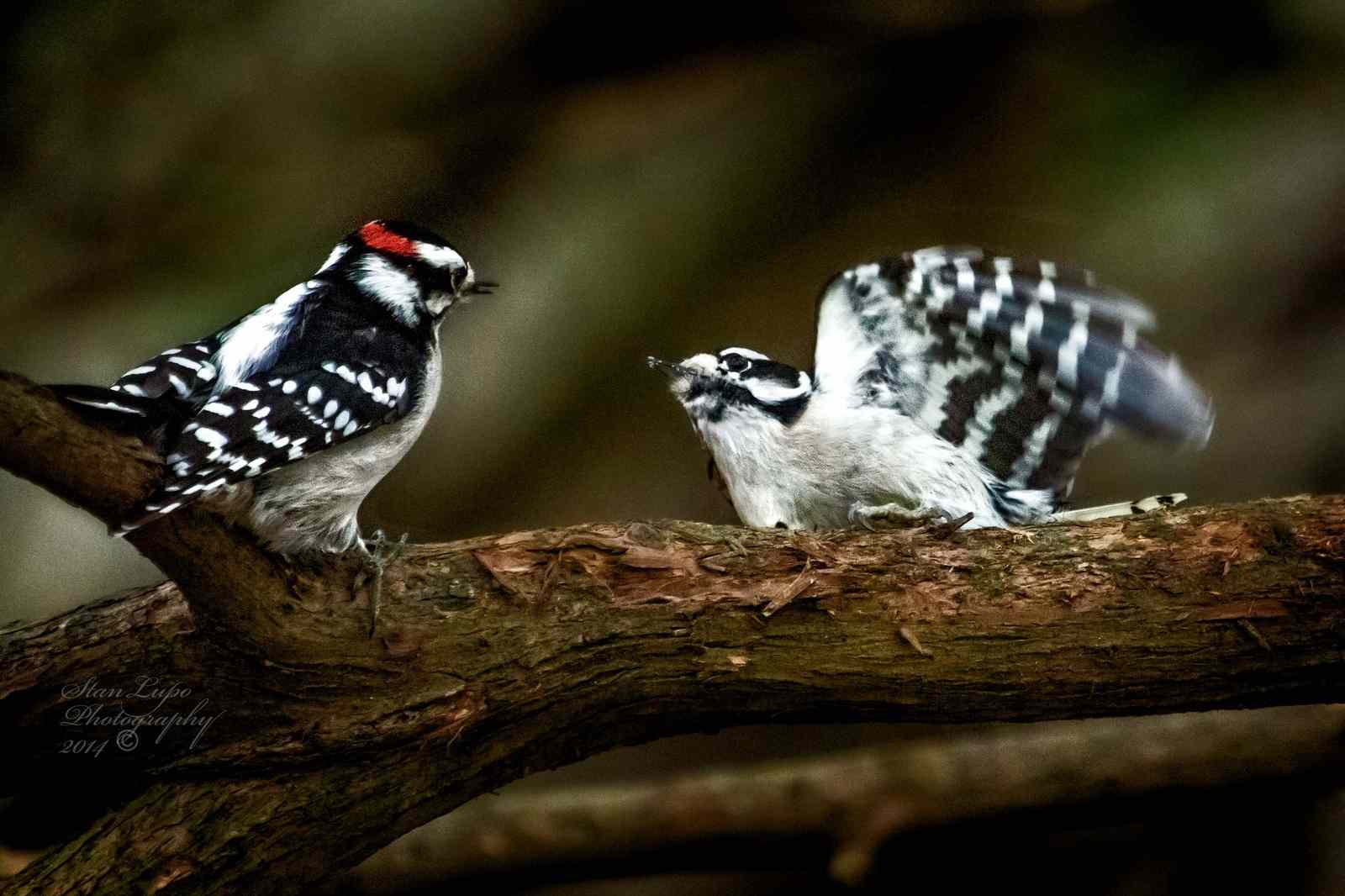
About Downy Woodpeckers:
- Downy Woodpeckers are small compared to most woodpeckers. They’re not much bigger than White-breasted Nuthatches and Black-capped Chickadees.
- Like White-breasted Nuthatches, Downy Woodpeckers will flock with other bird species in the winter.
- Downy Woodpeckers have distinctive high pitched calls, though they also often make percussive sounds by drumming on wood with their beaks rather than singing. This drumming is often territorial.
- Usually, females feed on larger tree branches and males on shorter ones.
12
Eastern Phoebe:
Eastern Phoebe description: Eastern Phoebes are round songbirds with brown backs and white undersides.
Favourite snacks: Insects
Listen to an Eastern Phoebe here.
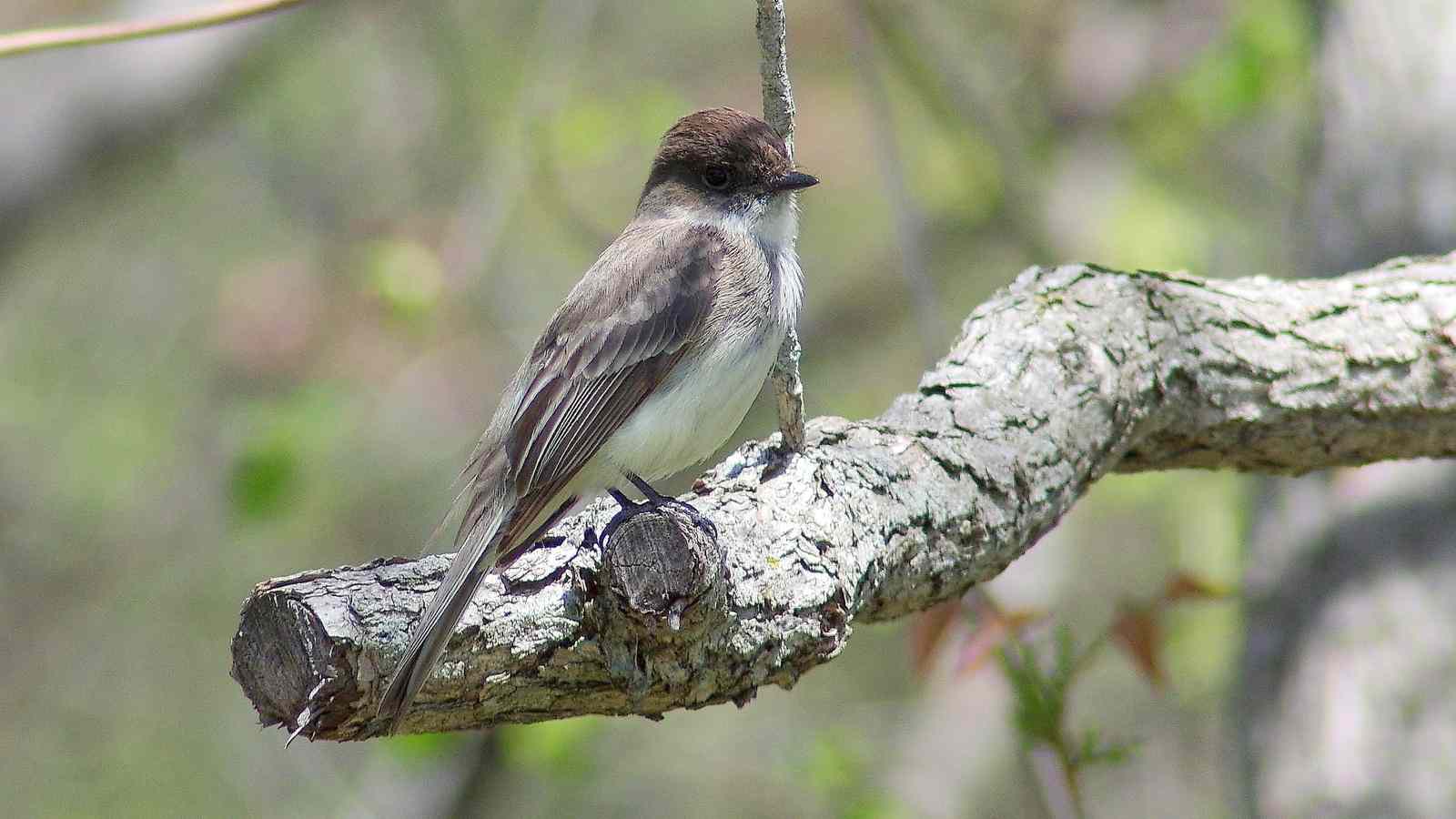
About Eastern Phoebes:
- The Eastern’s Phoebe gets its name from its raspy “fee-bee” call, which sounds like the name “Phoebe.”
- You’ll often hear this bird in the spring.
- When sitting on a perch, Eastern Phoebes will make a “tail wag” motion where they move their tail sideways and up and down. Watch the Eastern Phoebe wagging its tail here.
- These birds like their alone time. Even pairs tend not to spend much time together. When it’s time to lay eggs, the female will go so far as to chase the male away.
- Unlike many other birds, Eatern Phoebes will reuse nests year to year.
13
European Starling:
European Starling description: European Starlings have glossy and iridescent feathers that can be black with purple or green tones. They can also have white speckles, especially in the winter.
Favourite snack: Fruit, seeds, caterpillars, insects
Listen to a European Starling here.
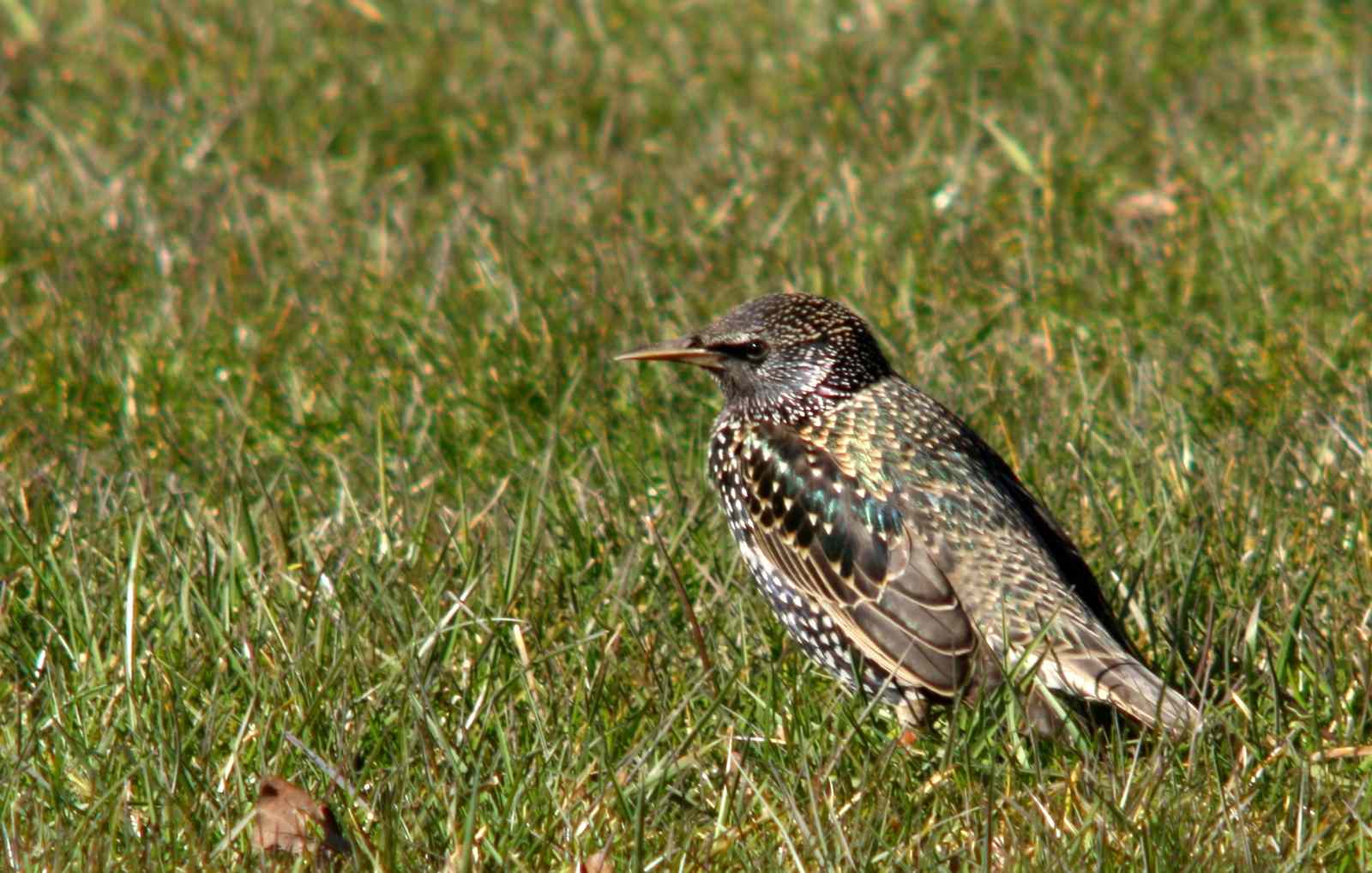
About European Starlings:
- European Starlings often gather on lawns or park grounds in large, loud flocks.
- European Starlings are gifted impersonators. They can learn and mimic up to 20 different species’ calls, ranging from the Red-tailed Hawk to the Wood Thrush. They can even mimic human words. Watch Stella the Starling speaking here.
- Not actually native to North America, they’re one of the most successful invasive species in the world. European Shakespeare enthusiasts brought them here in the 1800s because their famed mimicry abilities were mentioned in his work.
14
House Sparrow (You might also see: Song Sparrow, American Tree Sparrow, White-Crowned Sparrow, and White-Throated Sparrow):
House Sparrow description: Male House Sparrows are black, white, and brown. Females are paler brown and grey.
Favourite snack: Birdseed
Listen to a House Sparrow here.
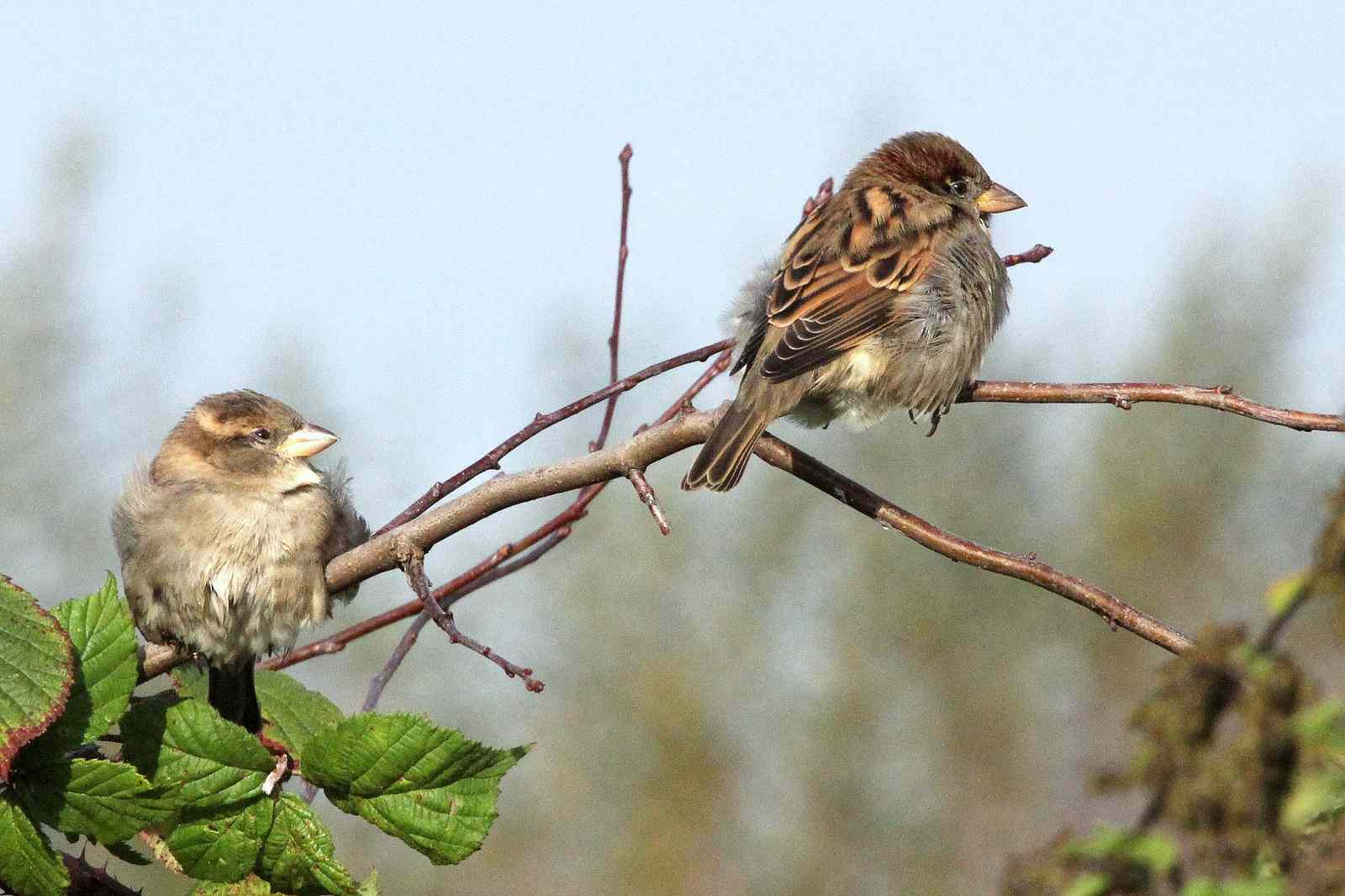
About House Sparrows:
- House Sparrows tend to live in areas with houses or buildings.
- They’re sociable, preferring to nest in colonies with social systems.
- Similar to chickens, house sparrows have a pecking order in their flocks. Males with more black patches tend to be higher in the pecking order.
- To get clean, they take dust baths. This is when they toss soil and dust over their bodies as if washing with water.
15
House Wren:
House Wren description: House Wrens are small brown birds with short tails.
Favourite snack: Insects
Listen to a House Wren here.

About House Wrens:
- Look for them near shrubs and on low branches singing their long, loud, and complex songs.
- They can be very aggressive when competing for nest holes, and will attack adult birds much larger than themselves to secure a coveted spot.
- It’s believed that they intentionally bring spider egg sacs into their nests to eat the parasites that feed on nestlings.
16
Mallard:
Mallard description: Adult male Mallards have green heads, white collars, gray sides, and black tails with yellow beaks. Females have brown speckled bodies and beaks.
Favourite snack: Seeds, roots, and the stems of bulrushes
Listen to a Mallard here.
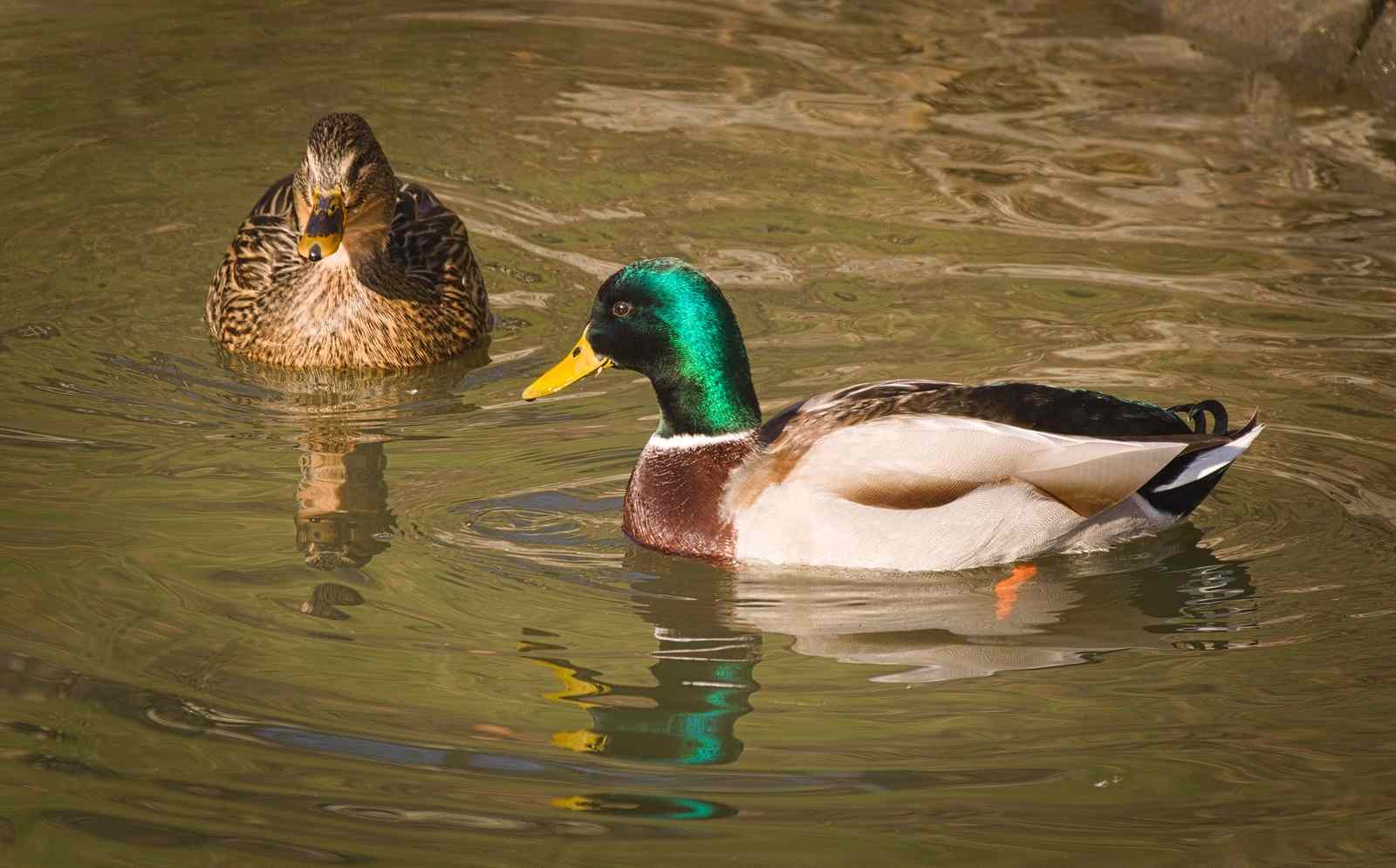
About Mallards:
- Mallards are the ancestor of almost every domestic duck breed and are the most abundant duck world wide.
- Mallards have been known to mate with other species of ducks, producing hybrids.
- The stereotypical duck “quacking” sound is made by the female. The males make quieter, deeper, two-note rasping sounds.
17
Mourning Dove:
Mourning Dove description: Mourning Doves are elegant birds with light gray-brown and pinkish feathers, slim tails, and small heads.
Favourite snack: Millet and seeds
Listen to a Mourning Dove here.
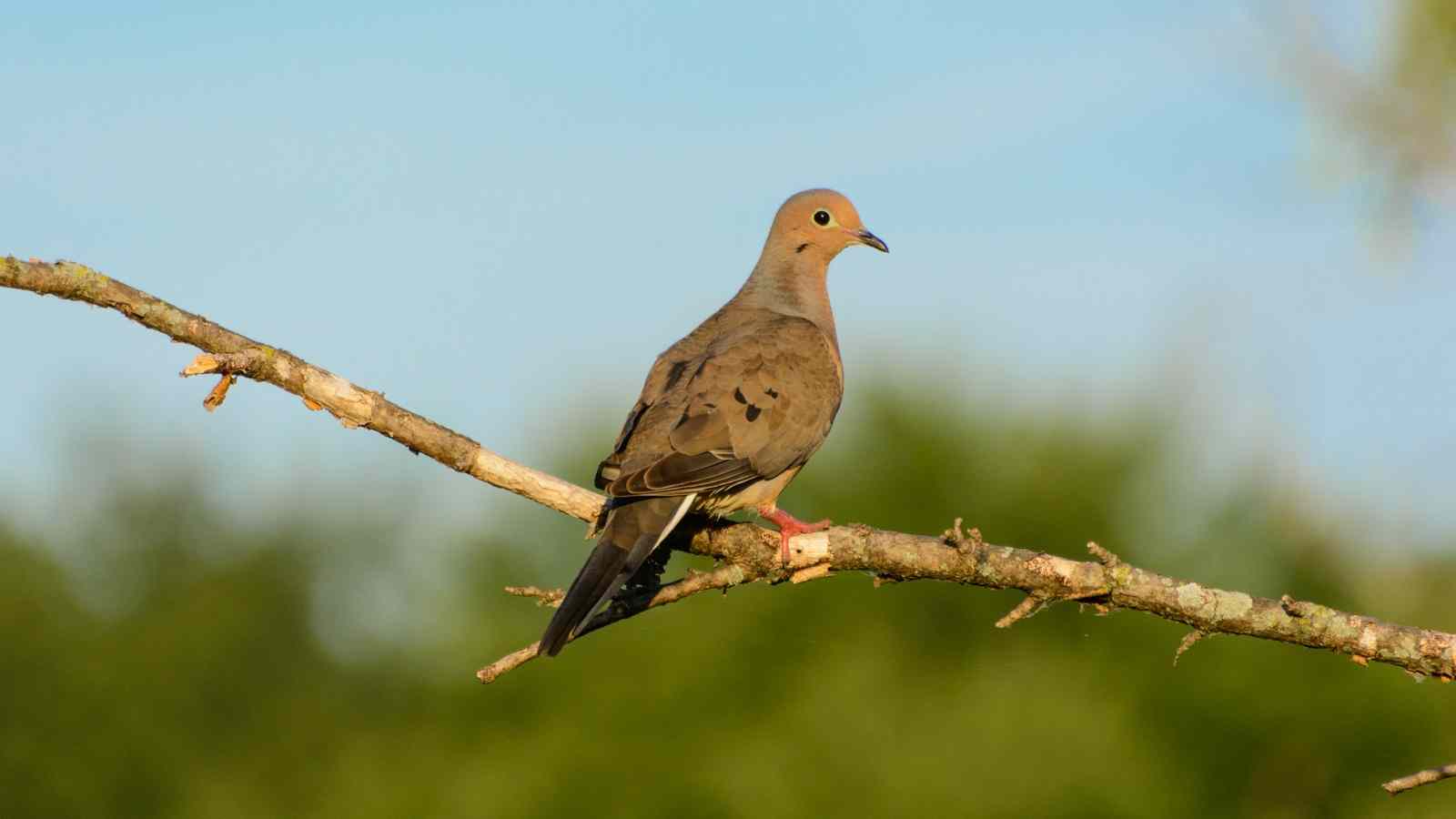
About Mourning Doves:
- Male Mourning Doves are known for their soft, mournful sounding, “coo-oo-oo-oo” calls. Far from being a sign of despair,, this signature sound is actually a mating call.
- Mourning Doves seem to love love. They are monogamous and form strong pair bonds. They’ll even stay together over the winter.
- As a bonding practice, pairs of Mourning Doves will gently nibble each other’s necks. After a while, they will grip each other’s beaks and bob their heads in sync. Watch a Mourning Dove courtship dance here.
18
Osprey:
Osprey description: Osprey are brown on top with white undersides. They’re large with long wings and legs, but they have slender bodies.
Favourite snack: Fish
Listen to an Osprey here.

About Osprey:
- You can recognize Osprey by the ‘M’ shape their bodies make when they fly.
- They are very good fishers, and can often be spotted along shorelines.
- Their bodies are well-suited to getting wet. They can close their nostrils when they dive into the water to fish, and their oily feathers prevent them from getting wet.
- Unlike most hawks, they have a reversible outer toe which helps them to grasp fish.
19
Peregrine Falcon:
Peregrine Falcon description: Peregrine Falcons are big blue-grey birds with long tails and long pointed wings.
Favourite snack: Other birds, such as Mourning Doves, Pigeons, and small songbirds
Listen to a Peregrine Falcon here.

About Peregrine Falcons:
- These fast and powerful birds are the fastest diving bird in the world.
- Peregrine Falcons are often considered one of the best hunters in the falcon family.
- They like to perch on tall structures (even skyscrapers or power poles), where they have a good view of their prey.
- In the mid-20th century, Peregrine Falcons were almost eliminated from eastern North America because of DDT pesticide poisoning. DDT was banned in the 1970s and there have since been restoration efforts. Now, they’re common in cities and shorelines.
20
Red-tailed Hawk:
Red-tailed Hawk description: Red-tailed Hawks have brownish backs, light bellies, wide red tails, and rounded wings. They can have variable plumage.
Favourite snack: Rodents like voles, rabbits, and squirrels
Listen to a Red-tailed Hawk here.
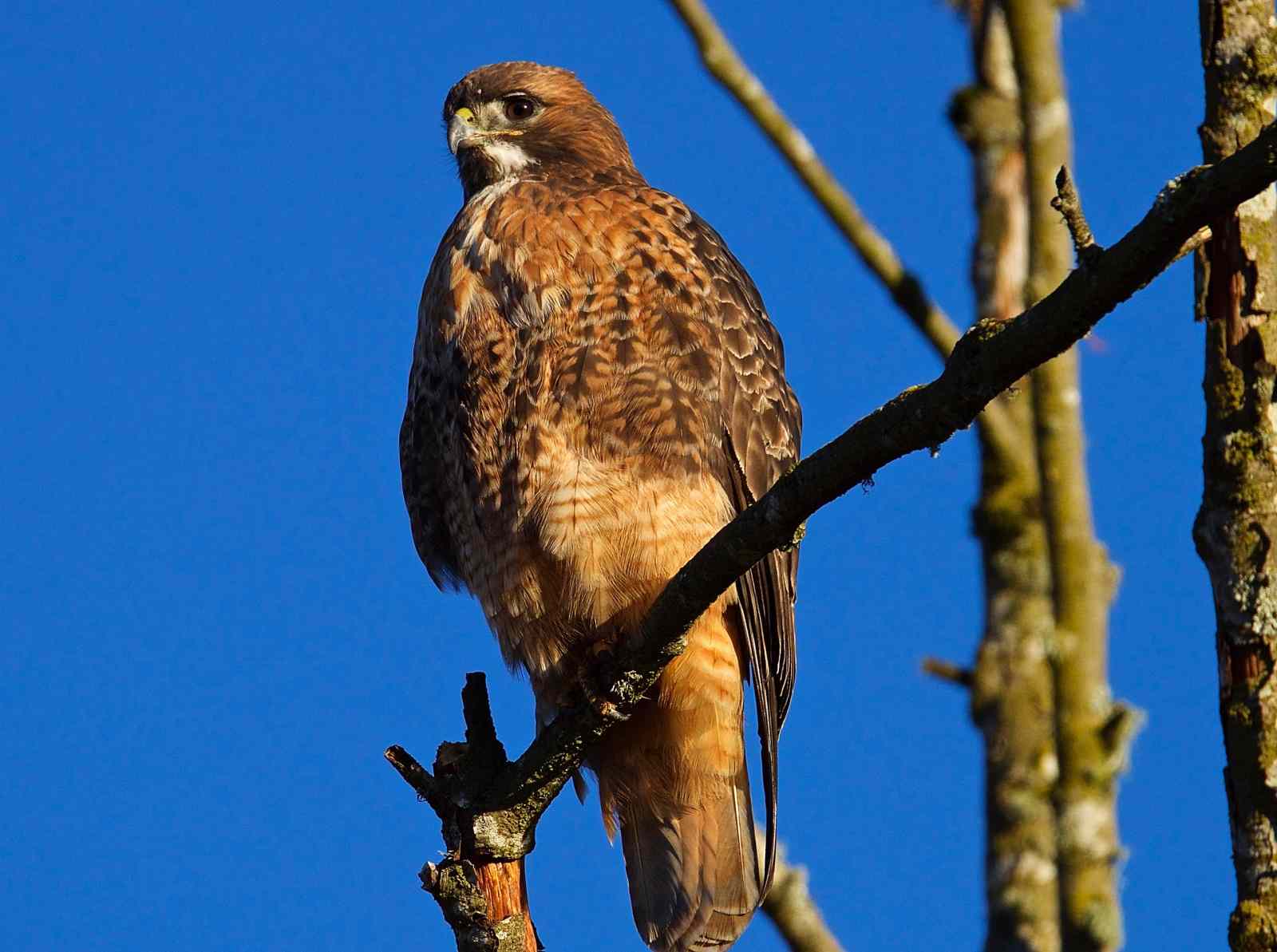
About Red-tailed Hawks:
- Male and female Red-tailed Hawks look similar, but females are about one third larger. Females are so big they can be mistaken for eagles.
- Believe it or not, their chilling, scream-like calls are often mistaken for the calls of Bald Eagles.
- Sometimes, Red-tailed Hawk screeches are used as raptor sounds in movies.
- They occasionally hunt in pairs, working together to corner their prey.
- To see a Red-tailed Hawk, go for a drive near areas with fields or open spaces. You’ll often spot these birds circling overhead.
21
Rock Pigeon
Rock Pigeon description: Rock Pigeons have plump bodies with small heads. They are blue-grey and they have two wing bars. They can vary in colour, and can also be white, spotted, or pale rusty brown.
Favourite snack: Corn, peas, and grain
Listen to a Rock Pigeon here.
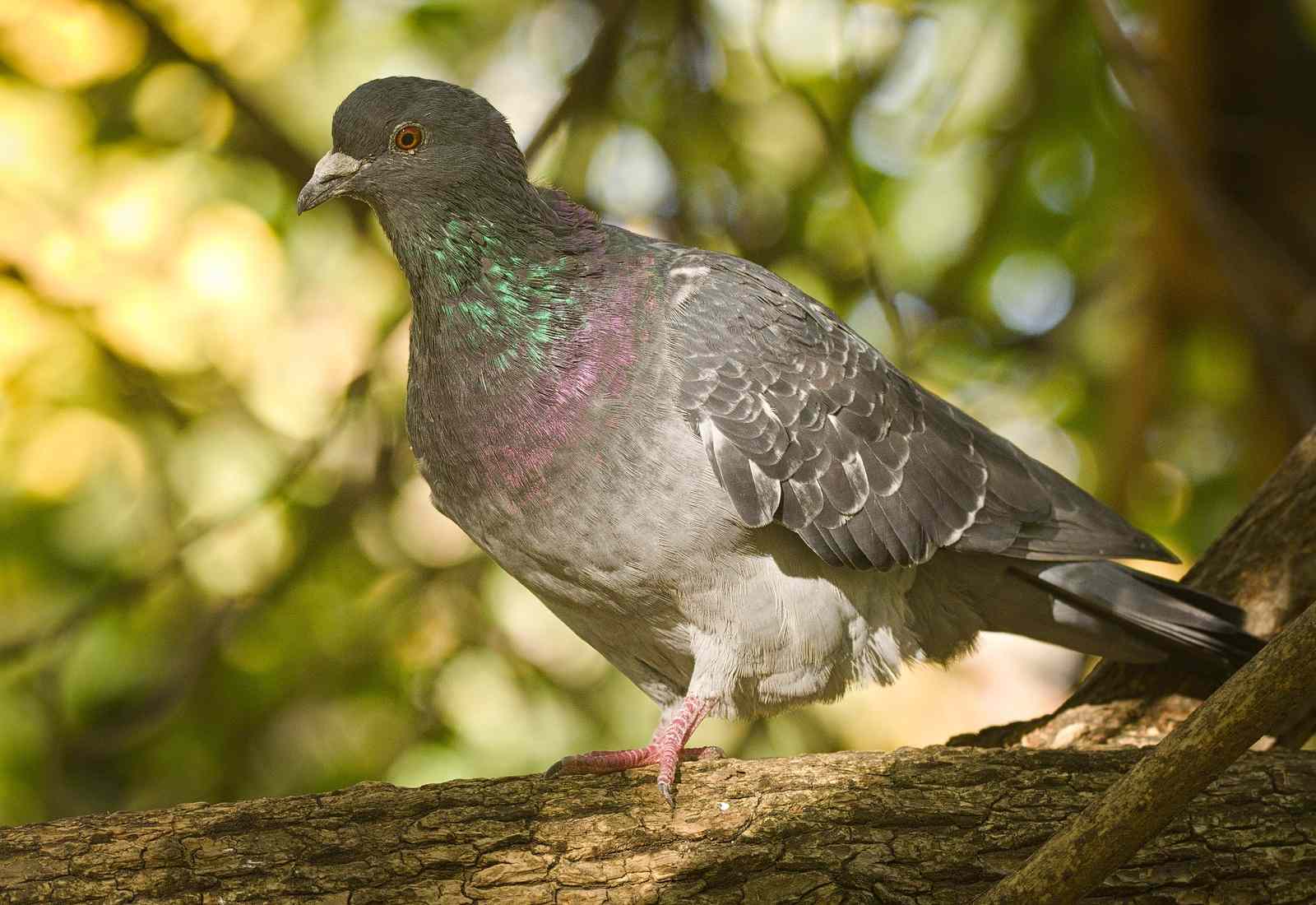
About Rock Pigeons:
- Rock Pigeons are great navigators. They use sound, smell, the position of the sun, an internal magnetic compass that uses the earth’s magnetic fields, and even manmade landmarks like highways to get around.
- They’re one of the few species that can recognize themselves in a mirror.
- Rock Pigeons may have been domesticated as early as 5000 years ago in Egypt and Mesopotamia.
- During World War I and II, they carried important messages.
22
Ruby-throated Hummingbird:
Ruby-throated Hummingbird description: Males are flashy metallic green with red patches under their throats. Females have green, black, and white bands and white throats. Both birds are very small with very long beaks.
Favourite snack: Nectar, sugar water, insects
Listen to a Ruby-throated Hummingbird here.
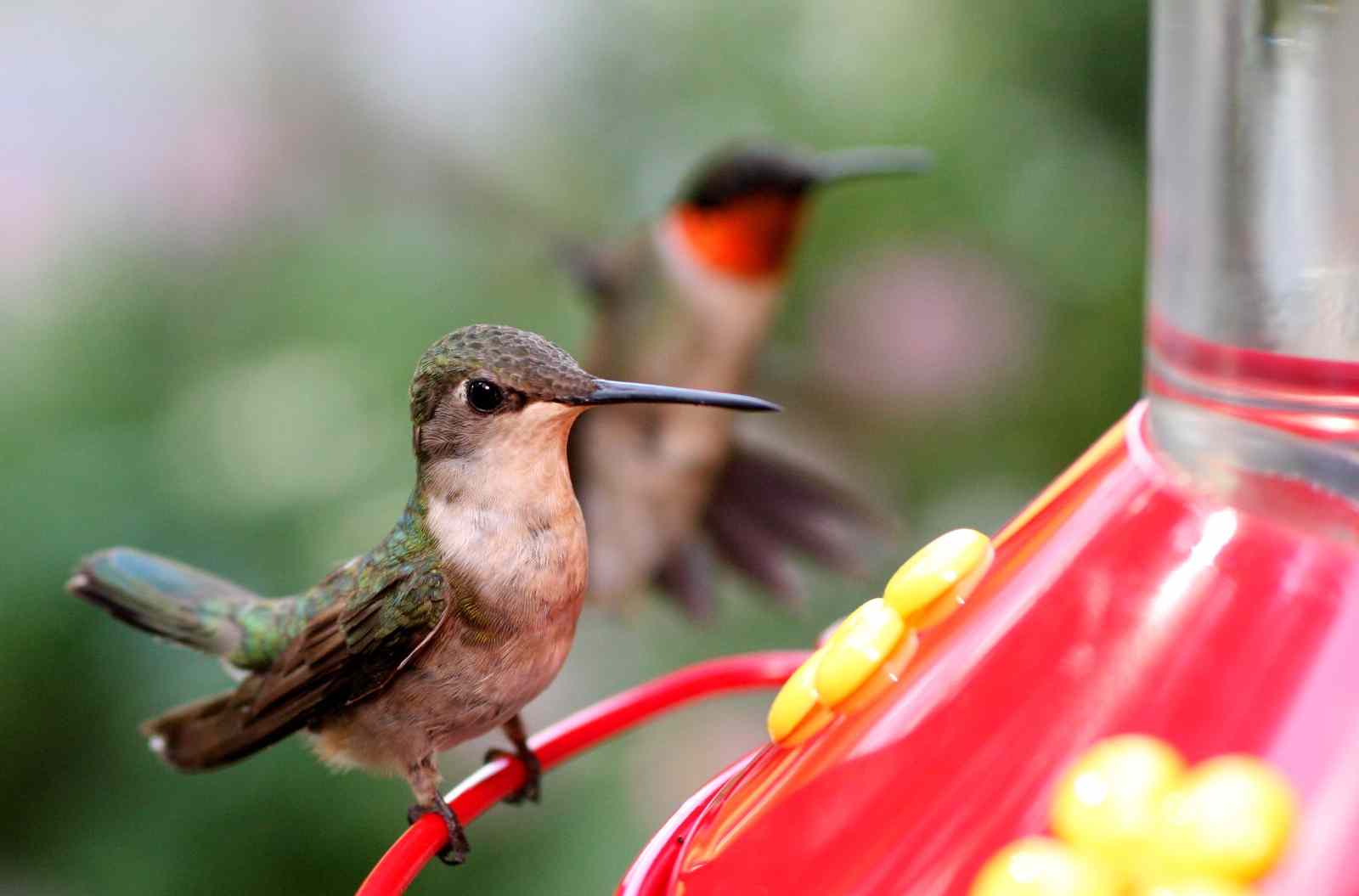
About Ruby-throated Hummingbirds:
- Ruby-throated Hummingbirds make high-pitched squeaks or twittering sounds.
- They pollinate plants while feeding from flower to flower.
- They can see colours humans can’t.
- They have such short legs, they can't walk or hop. They can only shuffle.
- Ruby-throated Hummingbirds fly by flapping their wings over 50 times per second.
- They can fly impressive distances, as far as from Costa Rica to Canada.
23
White-breasted Nuthatch (You might also see: Red-breasted Nuthatch):
White-breasted Nuthatch description: White-breasted nuthatches have black, gray, and white feathers, and rounded, compact bodies. They have very short tails.
Favourite snack: Insects and big seeds or nuts like acorns, sunflower seeds and peanuts
Listen to a White-breasted Nuthatch here.

About White-breasted Nuthatches:
- White-breasted Nuthatches have loud, nasal calls and curious personalities.
- They’re named for the way they eat. They “hatch” nuts by pushing nuts and seeds into trees and then pecking them until they crack open.
- These agile birds can move at strange angles quite quickly, even vertically up the trunks of trees.
- In the winter, they hang out with Chickadees or Titmice. This way, they can forage in flocks while also being on the lookout for predators.
24
Wood Thrush:
Wood Thrush description: Wood Thrushes have warm brown colouring with white, dark speckled undersides.
Favourite snack: Larvae, insects
Listen to a Wood Thrush here.
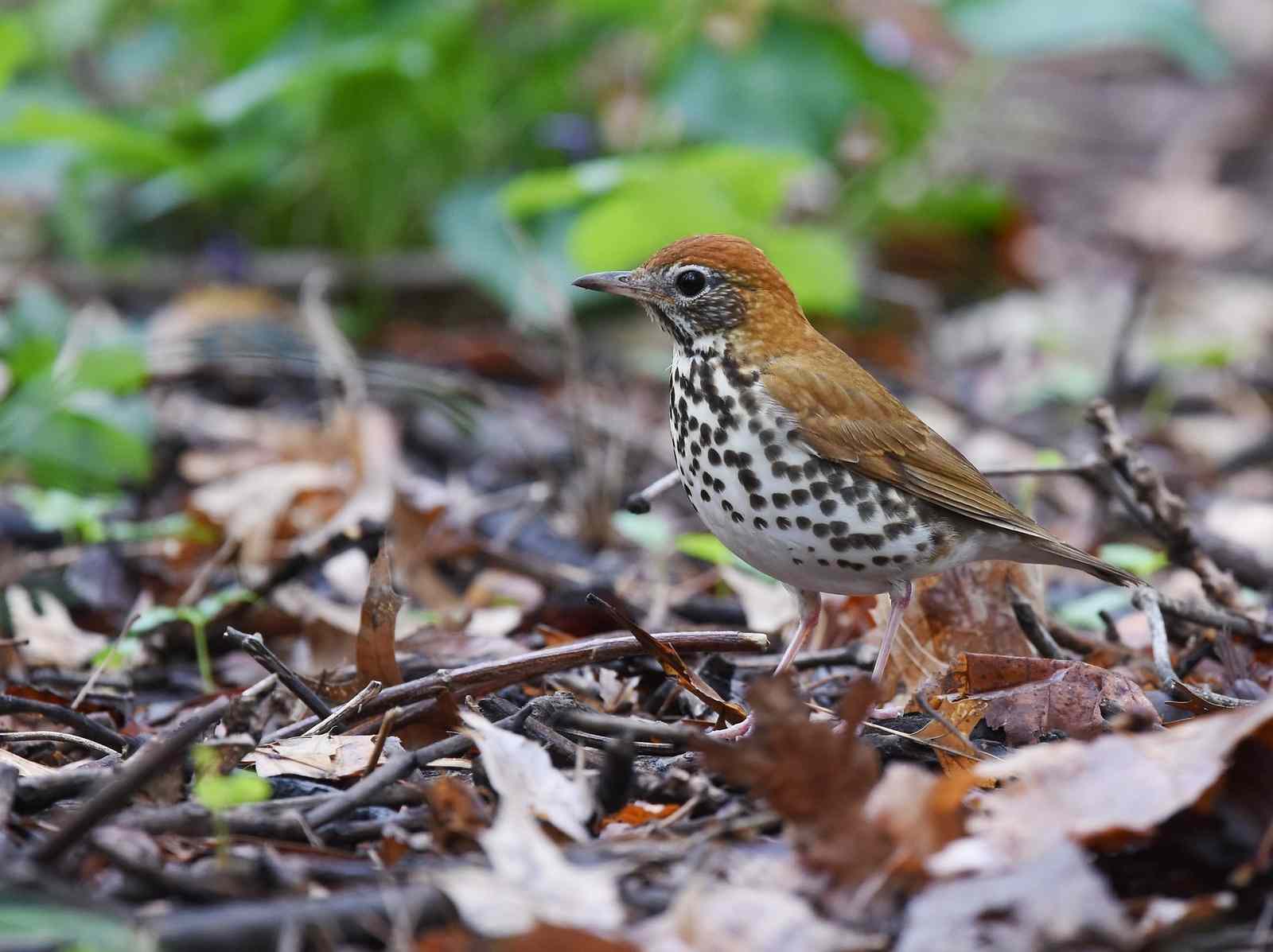
About Wood Thrushes:
- Wood Thrushes are talented singers. Males make a loud, trilling, flute-like ee-oh-lay song. They can even sing duets with themselves, singing two notes at the same time.
- They’re reclusive, solitary birds, although they will occasionally join flocks in the winter when things get tough.
- Like American Goldfinches, Wood Thrushes are vulnerable to nest parasitism by Brown-headed Cowbirds.
